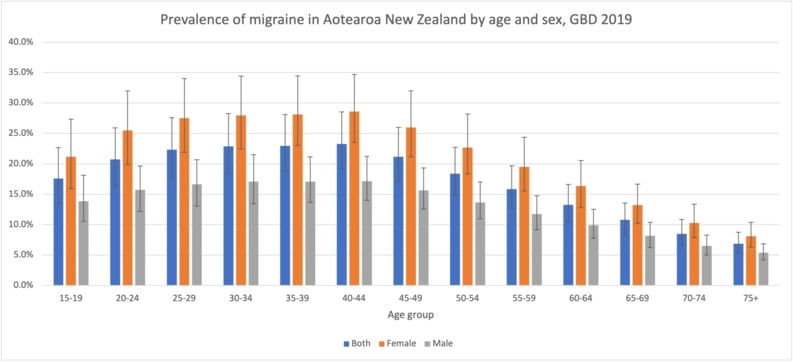Have you ever been told by a doctor you have migraines [sic]?
This is what people were asked in the 2013/14 New Zealand Health Survey, the last time the Ministry of Health collected data on the prevalence of migraine in Aotearoa New Zealand.
There are some obvious problems with this question.
What if you have migraine attacks but have never been to a doctor about them?
One of the best surveys of migraine in the world, from the US, estimates that only 61% of people with migraine disease have a medical diagnosis.(1)
What if you have migraine attacks but your doctor doesn’t recognise them or diagnoses you with something else?
From a study of nearly 1,200 patients in seven countries who were referred to a headache centre and subsequently diagnosed with migraine, only 8% of general practitioners and 35% of specialists consulted by these patients had formulated the correct diagnosis of migraine.(2) Patients thought they had sinusitis, tension headache and ‘cervical pain’, which is not a diagnosis at all.
Which creates another problem – what if you have migraine but you don’t know it?
Again from the same study, only 28% of patients with migraine disease were aware of it.
Another problem with this question about being told by a doctor you have migraine is the lack of any timeframe.
Migraine is a fluctuating disease and often dampens down in later life, especially in women, once estrogen levels settle down after menopause. What we really want to know, to get an estimate of the current disability and burden of the disease is how many people have had migraine attacks in recent times, how severe they are and how frequent.
But all that aside, we have finally got the results from the 2013/14 New Zealand Health Survey questions on migraine. These results were never published, but the questions were analysed, and the Ministry of Health (MoH) has released them to Migraine Foundation Aotearoa New Zealand.
Using the data, the MoH estimated an overall lifetime migraine prevalence of 15.7% (20.0% in women and 11.1% in men). For Māori, the prevalence was 16.0% (also 20.0% for women and 11.6% for men). For Pacific, the prevalence was 14.4% (19.3% for women and 9.1% for men), but because the sample of Pacific in the survey was relatively small, this is not significantly different from the estimates for Māori or European/Other ethnicities. Other research from New Zealand suggests that Pacific people who go to the doctor with headaches are less likely to be diagnosed with migraine than Europeans. (3)
We currently use estimates from the Global Burden of Disease (GBD) study when talking about how many people in Aotearoa have migraine disease. This is because of the problems with the NZ Health Survey migraine question and because up until now the most recent data published was from 2006/07.
The GBD study is an international research project that estimates mortality and disability from a large range of diseases throughout the world. For migraine, these estimates are based on annual not lifetime prevalence of migraine, making them more relevant to describe the current situation. (4) In the GBD study, the prevalence of migraine in Aotearoa New Zealand was estimated at 15.4% (18.9% for women and 11.5% for men.)
However, the GBD does not report on ethnicity, so these 2013/14 NZ Health Survey results are the best we have for Māori and Pacific people in Aotearoa.
While the MoH data confirms that the prevalence of migraine is similar, we do not yet know whether the impact and disability from migraine is the same for all people. Given the disparities in health status and access to health care by ethnicity that we know exist in New Zealand, it seems likely that the burden of migraine disease for Māori and Pacific people would be greater.
So, we need more research on this.
Our application to the MoH to include more useful questions about migraine is still under consideration. We will keep asking because we need this information to advocate for better treatment and support to be available for all patients with migraine in Aotearoa.

Global Burden of Disease Study 2019 (GBD 2019) Results. Seattle, United States: Institute for Health Metrics and Evaluation (IHME), 2020. Available from https://vizhub.healthdata.org/gbd-results/.
References
- Lipton RB, Nicholson RA, Reed ML, et al. Diagnosis, consultation, treatment, and impact of migraine in the US: Results of the OVERCOME (US) study. Headache. 2022 Feb;62(2):122-140. doi: 10.1111/head.14259
- Viana M, Khaliq F, Zecca C, et al. Poor patient awareness and frequent misdiagnosis of migraine: findings from a large transcontinental cohort. Eur J Neurol. 2020 Mar;27(3):536-541. doi: 10.1111/ene.14098.
- Thomson A, White G, West R. The prevalence of bad headaches including migraine in a multiethnic community. New Zealand Medical Journal. 1993; 106(967):477-480
- Global Burden of Disease Collaborative Network. Global Burden of Disease Study 2019 (GBD 2019) Results. 2020. Institute for Health Metrics and Evaluation (IHME): Seattle, United States. Available from https://vizhub.healthdata.org/gbd-results/


